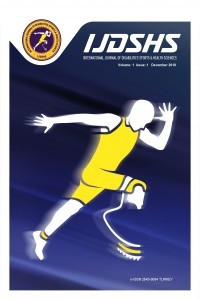Comparison of the Supervised and Home-Based Physiotherapy Program in Patients with Lateral Epicondylitis
Comparison of the Supervised and Home-Based Physiotherapy Program in Patients with Lateral Epicondylitis
Lateral Epicondylitis, Home Based Physiotherapy, Supervised Physiotherapy, Pain Function, Quality of Life,
___
- Ahmad, Z., Siddiqui, N., Malik, S. S., Abdus-Samee, M., Tytherleigh-Strong, G., & Rushton, N. (2013). Lateral epicondylitis: a review of pathology and management. The Bone & Joint Journal, 95-B(9), 1158–1164. Doi:10.1302/0301-620x.95b9.29285
- Alizadehkhaiyat, O., & Frostick, S. P. (2015). Electromyographic assessment of forearm muscle function in tennis players with and without Lateral Epicondylitis. Journal of Electromyography and Kinesiology, 25(6), 876–886. Doi.1016/j.jelekin.2015.10.013
- Argent, R., Daly, A., & Caulfield, B. (2018). Patient Involvement with Home-Based Exercise Programs: Can Connected Health Interventions Influence Adherence? JMIR mHealth and uHealth, 6(3), e47. Doi: 10.2196/mhealth.8518
- Brummel, J., Baker, C. L., 3rd, Hopkins, R., & aker, C. L., Jr (2014). Epicondylitis: lateral. Sports Medicine and Arthroscopy Review, 22(3),e1–e6.Doi:10.1097/JSA.00000000000 00024
- Cohen, M., & da Rocha Motta Filho, G. (2015). Lateral Epicondylitis of The Elbow. Revista Brasileira de Ortopedia, 47(4), 414–420. Doi:10.1016/S2255-4971(15)30121-X
- Day, J. M., Lucado, A. M., & Uhl, T. L. (2019). A Comprehensive Rehabilitation Program for Treating Lateral Elbow Tendinopathy. International Journal of Sports Physical Therapy, 14(5), 818–829.
- Dimitrios S. (2016). Lateral Elbow Tendinopathy: Evidence of Physiotherapy Management. World Journal of Orthopedics, 7(8), 463–466. Doi: 10.5312/wjo.v7.i8.463
- Dimitrios, S. & Manias, P. (2013). Comparing Two Exercise Programmes for the Management of Lateral Elbow Tendinopathy (Tennis Elbow/Lateral Epicondylitis)-A Controlled Clinical Trial. The Open Access Journal of Science and Technology, 1: 1-8. DOI: 10.11131/2013/100013
- Düger, T., Yakut, E., Öksüz, Ç., Yörükan, S., Semin Bilgütay, B., Ayhan, Ç., Leblebicioğlu, G., Kayıhan, H., Kırdı, N., Yakut, Y., Güler, Ç. (2006). Reliability and Validity of the Turkish Version of the Disabilities of the Arm, Shoulder and Hand (DASH) Questionnaire. Physiotherapy Rehabilitation, 17(3);99-107.
- Granviken, F., & Vasseljen, O. (2015). Home Exercises and Supervised Exercises Are Similarly Effective for People with Subacromial Impingement: A Randomised Trial. Journal of Physiotherapy, 61(3), 135–141. Doi: 10.1016/j.jphys.2015.05.014
- Gutiérrez-Espinoza, H., Araya-Quintanilla, F., Cereceda-Muriel, C., Álvarez-Bueno, C., Martínez-Vizcaíno, V., & Cavero-Redondo, I. (2020). Effect of Supervised Physiotherapy Versus Home Exercise Program in Patients with Subacromial Impingement Syndrome: A Systematic Review and Meta-Analysis. Physical Therapy in Sport, 41, 34–42. Doi: 10.1016/j.ptsp.2019.11.003
- Koçyiğit, H., Aydemir, Ö., Ölmez, N. ve Memiş, A. (1999). Reliability and Validity of the Turkish Version of Short Form-36 (SF36). Journal of Medicine and Treatment, 12(2), 102-106.
- Ma, K. L., & Wang, H. Q. (2020). Management of Lateral Epicondylitis: A Narrative Literature Review. Pain Research & Management, 2020, 6965381. Doi:10.1155/2020/6965381
- Manias, P., & Stasinopoulos, D. (2006). A Controlled Clinical Pilot Trial to Study the Effectiveness of Ice as a Supplement to the Exercise Programme for the Management of Lateral Elbow Tendinopathy. British Journal of Sports Medicine, 40(1), 81–85. Doi:10.1136/bjsm.2005.020909
- Martinez-Silvestrini, J. A., Newcomer, K. L., Gay, R. E., Schaefer, M. P., Kortebein, P., & Arendt, K. W. (2005). Chronic Lateral Epicondylitis: Comparative Effectiveness of a Home Exercise Program Including Stretching Alone Versus Stretching Supplemented with Eccentric or Concentric Strengthening. Journal of Hand Therapy: Official Journal of the American Society of Hand Therapists, 18(4), 411–420. Doi: 10.1197/j.jht.2005.07.007
- Peterson, M., Butler, S., Eriksson, M., & Svärdsudd, K. (2014). A Randomized Controlled Trial of eccentric vs. Concentric Graded Exercise in Chronic Tennis Elbow (Lateral Elbow Tendinopathy). Clinical Rehabilitation, 28(9), 862–872. Doi: 10.1177/0269215514527595
- Samagh, P., Sudhakar, K., & Jindal, R. (2015). The Impact of Lateral Epicondylitis On Quality of Life. International Journal of Physiotherapy, 2, 627-632.
- Stasinopoulos, D., Stasinopoulou, K., & Johnson, M. I. (2005). An Exercise Programme for the management of Lateral Elbow Tendinopathy. British Journal of Sports Medicine, 39(12), 944–947. Doi:10.1136/bjsm.2005.019836
- Svernlöv, B., & Adolfsson, L. (2001). Non-operative Treatment Regime Including Eccentric Training for Lateral Humeral Epicondylalgia. Scandinavian Journal of Medicine & Science in Sports, 11(6), 328–334. Doi: 10.1034/j.1600-0838.2001.110603.x
- van Ark, M., Cook, J. L., Docking, S. I., Zwerver, J., Gaida, J. E., van den Akker-Scheek, I., & Rio, E. (2016). Do isometric and isotonic exercise programs reduce pain in athletes with patellar tendinopathy in-season? A randomised clinical trial. Journal of science and medicine in sport, 19(9), 702–706
- Vaquero-Picado, A., Barco, R., & Antuña, S. A. (2017). Lateral Epicondylitis of the Elbow. EFORT Open Reviews, 1(11), 391–397. Doi:10.1302/2058-5241.1.000049
- Waugh, E. J., Jaglal, S. B., Davis, A. M., Tomlinson, G., & Verrier, M. C. (2004). Factors Associated with Prognosis of Lateral Epicondylitis After 8 Weeks of Physical Therapy. Archives of Physical Medicine and Rehabilitation, 85(2), 308–318 Doi:10.1016/s0003-9993(03)00480-5.
- Weber, C., Thai, V., Neuheuser, K., Groover, K., & Christ, O. (2015). Efficacy of Physical Therapy for the Treatment of Lateral Epicondylitis: A Meta-Analysis. BMC Musculoskeletal Disorders, 16, 223. Doi:10.1186/s12891-015-0665-4
- Wen, D. Y., Schultz, B. J., Schaal, B., Graham, S. T., & Kim, B. S. (2011). Eccentric Strengthening for Chronic Lateral Epicondylosis: A Prospective Randomized Study. Sports Health, 3(6), 500–503. Doi: 10.1177/1941738111409690
- Yayın Aralığı: Yılda 3 Sayı
- Başlangıç: 2018
- Yayıncı: Nevzat DEMİRCİ
Yunus Emre BAŞ, Nihan ÖZÜNLÜ PEKYAVAŞ, Oya ÜMİT YEMİŞÇİ
Güler ATALAY, Emre Serdar ATALAY
Güleser GÜNEY YILMAZ, Gözde ÖNAL
Examination of Elite Physically Disabled Athletes' Motivation Levels of Participation in Sports
Atike YILMAZ, Abdullah GÜMÜŞAY, Cemre Can AKKAYA
Özlem ÜÇEL, Filiz EYÜBOĞLU, Ayşe Reyhan ÇELİKER
Ozan GÜR, Selda BAŞAR, Erdinç ESEN, Baybars ATAOGLU, Sacit TURANLI
